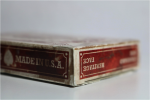How are playing cards made? The art and craft of playing card manufacturing
Playing cards have a captivating allure that transcends time and borders. They are the silent companions of countless game nights, the catalysts for laughter and friendly competition. But have you ever wondered about the remarkable journey these unassuming rectangles of paper or plastic have taken to land in your hands? Join us as we travel through history and delve into the ancient beginnings of playing cards.
From the intricately handcrafted cards of ancient China to the sophisticated manufacturing processes of today, we’ll unveil the secrets behind the art and craft of playing card production. Let’s step into a world where artistry meets precision and discover how playing cards are made.
The Origins and Evolution of Playing Cards
Playing cards have a rich and captivating history that spans centuries and continents. In this section, we’ll explore the origins and evolution of these timeless gaming tools, uncovering the secrets behind their enduring popularity.
Ancient Beginnings
The roots of playing cards can be traced back to ancient China during the Tang Dynasty (618-907 AD). The earliest recorded evidence of playing cards dates to the 9th century, where they were used for entertainment and gambling. These early cards were meticulously crafted by hand from paper or thin sheets of ivory, featuring intricate designs inspired by Chinese culture and mythology.
The Spread of Cards
From China, playing cards gradually spread across Asia, finding their way to the Middle East and eventually Europe. The Mamluks of Egypt are often credited with introducing cards to Europe in the 14th century. These early cards featured elaborate calligraphy and exotic designs, reflecting the cultural influences of the Islamic world.
Standardization and Printing
The advent of the printing press in the 15th century revolutionized playing card production. The printing press allowed for mass production, making cards more affordable and accessible. European card makers began experimenting with different designs, suits, and numbering systems, gradually establishing the standard deck structure we recognize today.
The Anatomy of a Playing Card
To truly understand how playing cards are made, it’s essential to familiarize ourselves with the various components that make up a typical deck. In this section, we’ll explore the intricate details that contribute to the construction and quality of playing cards.
The Card Stock
Modern playing cards are typically crafted from a specialized cardstock that strikes the perfect balance between flexibility and durability. This cardstock is often a blend of paper and plastic fibers, ensuring that the cards can withstand frequent shuffling and handling. Manufacturers carefully select materials that provide a smooth surface for easy card manipulation and a substantial weight that feels comfortable in the hand.
The Printing Process
Printing technology has come a long way since the early days of playing card production. Today, most playing cards are printed using offset lithography, a technique that allows for high-quality, vibrant designs. The cards are printed in large sheets, utilizing precision color separation techniques to ensure accuracy and consistency in the final product. Once printed, the sheets are carefully inspected for any imperfections before moving on to the cutting phase.
Finishing Touches
Once the cards have been printed and cut, they undergo several finishing processes to enhance their appearance and durability. One of the crucial steps is applying a protective varnish or laminate coating to protect against wear and tear, ensuring the cards can withstand countless games. Additionally, the edges of the cards are often rounded or beveled to prevent fraying and improve handling. These finishing touches contribute to the longevity and tactile experience of the cards.
I thought cards were made of pasteboard
Pasteboard, a thick and rigid type of cardboard, was commonly used as a material for playing cards in the past. It provided durability and stiffness to the cards, allowing them to withstand repeated use and maintain their shape.
During the 18th and 19th centuries, pasteboard was a popular choice for playing card production, particularly in Europe. It was created by layering and compressing multiple sheets of paper pulp together, resulting in a sturdy and dense material.
However, as printing and manufacturing technologies advanced, pasteboard gradually fell out of favour as a primary material for playing cards. Modern playing cards are now typically made from specialized cardstock, which combines paper and plastic fibers to achieve a balance between flexibility and durability.
Customizations and Collector’s Editions
Playing cards have evolved from mere gaming tools to objects of art and self-expression. In this section, we’ll dive into the world of custom-made and collector’s edition playing cards, where creativity and imagination take center stage.
Custom Designs and Themes
In recent years, there has been an explosion of custom-designed playing cards that cater to different interests and aesthetics. Artists and designers collaborate with card manufacturers to create unique decks that showcase their creativity and vision. From minimalist designs that focus on clean lines and simplicity to intricate illustrations that bring fantasy worlds to life, the possibilities are endless. Custom decks often feature thematic elements, ranging from nature-inspired motifs to pop culture references, allowing players to personalize their gaming experience.
Limited Editions and Rare Finds
For avid playing card collectors and enthusiasts, playing cards hold a special allure. Limited edition decks, produced in small quantities, become sought-after treasures. These decks often boast luxurious materials, intricate craftsmanship, and elaborate designs. Some decks even incorporate precious metals, gems, or hand-painted elements, elevating them to the realm of exquisite art pieces. The allure of limited editions lies in their exclusivity, with collectors eagerly acquiring these rare finds to showcase and preserve a piece of playing card history.
Unusual Facts about Playing Cards
Beyond their artistic and gaming value, playing cards have a treasure trove of intriguing and lesser-known facts. Did you know that the Ace of Spades is considered the most prestigious card in a deck? Historically, it was used to indicate tax payments or carry specific messages, and it still holds a symbolic significance in certain games. Additionally, the court cards (King, Queen, and Jack) are believed to represent historical figures, such as Charlemagne, Judith, and Lancelot, adding a touch of regal history to every game.
There are famous decks of playing cards, decks that were used to hide maps and messages during the war, and extremely rare playing cards which can make a collector drool.
From their ancient origins in China to their widespread popularity across the globe, playing cards have evolved, adapting to new technologies and artistic expressions. With a careful selection of materials, precise printing techniques, and unique designs, playing card manufacturers continue to craft intricate and engaging decks that captivate players and collectors alike. Whether for gaming, magic tricks, throwing, or artistic appreciation, playing cards hold a timeless charm that transcends borders and generations. Now the next time you hold a deck of playing cards, you can take a moment to appreciate the craftsmanship and history that lies within each card.





